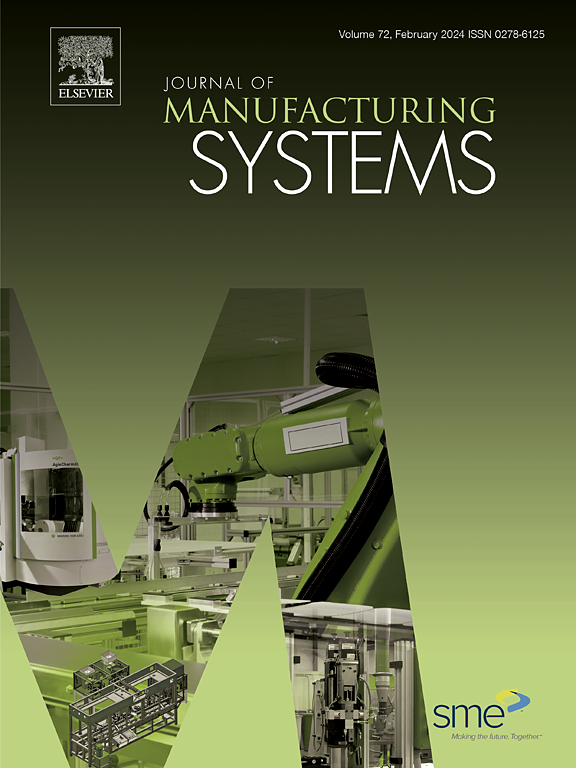机器人上胶系统的数字孪生建模,用于预测上胶线质量和优化上胶参数
IF 14.2
1区 工程技术
Q1 ENGINEERING, INDUSTRIAL
引用次数: 0
摘要
数字孪生(DT)技术正在改变当前智能制造的模式,它弥补了工艺参数优化方法的不足,提高了实时性和可预测性。本文建立了机器人上胶系统的DT模型,用于预测上胶线的质量(宽度和厚度)以及优化上胶参数(轨迹和挤出速度)。构建了基于几何、物理、行为和规则模型的DT框架,实时监控和优化粘接参数。建立了一种基于鲸鱼优化算法(WOA)的改进的反向传播神经网络(BPNN)预测模型,从历史和实时数据中预测胶线的宽度和厚度,同时实时计算胶线的横截面积。采用非支配排序遗传算法(NSGA-II)构建多目标优化模型,对粘接参数进行优化。研制了机器人上胶系统的DT样机,并进行了实验验证。利用几何模型的位置标定,在涂胶前对涂胶轨迹进行校正,涂胶点的位置误差在± 0.5 mm以内。设计了粘接轨迹,验证了粘接参数自适应优化的有效性。胶线宽度和厚度的预测误差分别控制在± 0.5 mm和± 0.3 mm之间。参数优化后,转角处的胶线宽度和厚度分别减小了4.53 %和7.54 %,避免了胶水的堆积。这一减少解决了胶线质量一致性差的问题,验证了基于DT模型的一体化监测、预测和优化的可行性。本文章由计算机程序翻译,如有差异,请以英文原文为准。
Digital twin modeling of the robotic gluing system for predicting the quality of glue lines and optimizing gluing parameters
Digital twin (DT) technology is changing the current pattern of intelligent manufacturing, it makes up for the shortcomings of process parameter optimization methods to improve real-time and predictability. This paper developed DT models for the robotic gluing system to predict the quality (width and thickness) of glue lines and optimize gluing parameters (trajectory and extrusion speeds). The DT framework based on the geometric, physical, behavioral, and rule models is constructed to monitor and optimize the gluing parameters in real-time. An improved backpropagation neural network (BPNN) prediction model based on whale optimization algorithm (WOA) is established to predict the width and thickness of glue lines from historical and real-time data, while simultaneously enabling real-time calculation of the cross-sectional area of glue lines. A multi-objective optimization model constructed using non-dominated sorting genetic algorithm (NSGA-II) is used to optimize the gluing parameters. The DT prototype of the robotic gluing system has been developed and verified experimentally. The position calibration of the geometric model is used to correct the gluing trajectory before gluing, and the position errors of the gluing points are within ± 0.5 mm. The gluing trajectory is designed to test the effectiveness of the adaptive optimization of gluing parameters. The prediction errors of the width and thickness of the glue line are controlled between ± 0.5 mm and ± 0.3 mm, individually. After parameter optimization, the width and thickness of the glue line at the corner are reduced by 4.53 % and 7.54 %, respectively, thus avoiding glue accumulation. This reduction solves the problem of poor consistency in the quality of glue lines and verifies the feasibility of integrated monitoring, prediction, and optimization based on the DT model.
求助全文
通过发布文献求助,成功后即可免费获取论文全文。
去求助
来源期刊

Journal of Manufacturing Systems
工程技术-工程:工业
CiteScore
23.30
自引率
13.20%
发文量
216
审稿时长
25 days
期刊介绍:
The Journal of Manufacturing Systems is dedicated to showcasing cutting-edge fundamental and applied research in manufacturing at the systems level. Encompassing products, equipment, people, information, control, and support functions, manufacturing systems play a pivotal role in the economical and competitive development, production, delivery, and total lifecycle of products, meeting market and societal needs.
With a commitment to publishing archival scholarly literature, the journal strives to advance the state of the art in manufacturing systems and foster innovation in crafting efficient, robust, and sustainable manufacturing systems. The focus extends from equipment-level considerations to the broader scope of the extended enterprise. The Journal welcomes research addressing challenges across various scales, including nano, micro, and macro-scale manufacturing, and spanning diverse sectors such as aerospace, automotive, energy, and medical device manufacturing.
 求助内容:
求助内容: 应助结果提醒方式:
应助结果提醒方式:


